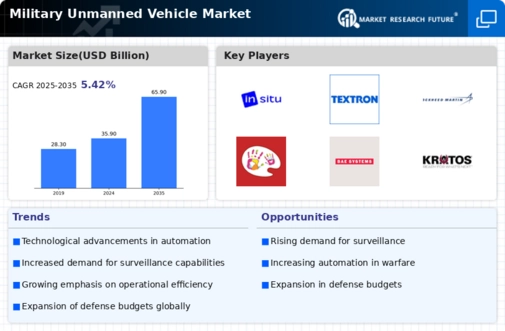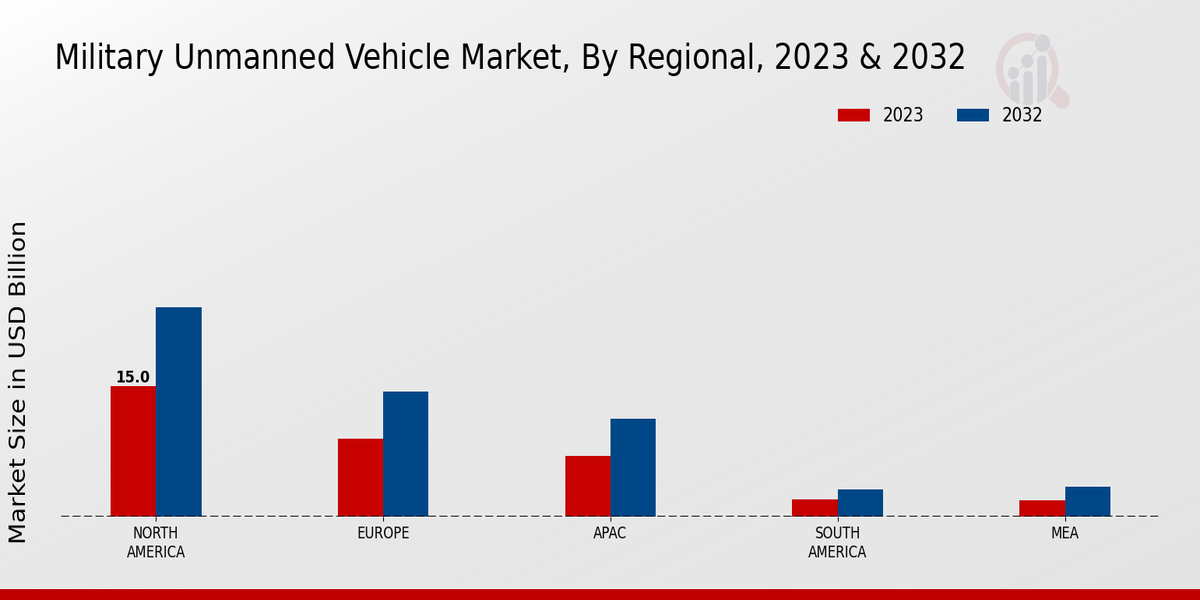Increased Defense Budgets
The Global Military Unmanned Vehicle Market Industry is experiencing growth driven by rising defense budgets across various nations. Countries are prioritizing the enhancement of their military capabilities, leading to increased investments in unmanned systems. For instance, the United States has allocated substantial funds to develop advanced unmanned aerial vehicles and ground systems. This trend is mirrored in nations like India and China, which are also ramping up their defense spending. As a result, the market is projected to reach 35.9 USD Billion in 2024, reflecting a robust commitment to modernizing military operations through unmanned technologies.
Market Growth Projections
The Global Military Unmanned Vehicle Market Industry is poised for substantial growth, with projections indicating a market size of 35.9 USD Billion in 2024 and an anticipated increase to 65.9 USD Billion by 2035. This growth trajectory suggests a compound annual growth rate of 5.68% from 2025 to 2035, reflecting the increasing reliance on unmanned systems in military operations. The expansion of this market is driven by various factors, including technological advancements, rising defense budgets, and the growing demand for surveillance capabilities. As nations continue to invest in unmanned technologies, the market is likely to evolve significantly over the coming years.
Technological Advancements
Rapid technological advancements are significantly influencing the Global Military Unmanned Vehicle Market Industry. Innovations in artificial intelligence, machine learning, and sensor technologies are enhancing the capabilities of unmanned vehicles, making them more effective in combat and reconnaissance missions. For example, the integration of AI in drone operations allows for autonomous decision-making, improving mission efficiency. As these technologies evolve, they are expected to drive market growth, with projections indicating a market size of 65.9 USD Billion by 2035. This growth underscores the importance of staying at the forefront of technological developments in military applications.
Regulatory Support and Policy Frameworks
Regulatory support and favorable policy frameworks are essential drivers in the Global Military Unmanned Vehicle Market Industry. Governments are establishing guidelines and standards to facilitate the integration of unmanned systems into military operations. This regulatory environment encourages investment and innovation, enabling defense contractors to develop and deploy advanced unmanned vehicles. For instance, the establishment of clear operational protocols for drone usage in military contexts has streamlined the approval process for new technologies. As nations continue to refine their regulatory approaches, the market is expected to benefit from increased confidence among stakeholders, fostering further growth.
Strategic Partnerships and Collaborations
Strategic partnerships and collaborations among defense contractors and technology firms are shaping the Global Military Unmanned Vehicle Market Industry. These alliances facilitate the sharing of expertise and resources, leading to the development of innovative unmanned systems. For example, collaborations between aerospace companies and software developers are resulting in advanced drone technologies that enhance operational capabilities. Such partnerships not only accelerate product development but also expand market reach. As the industry evolves, these collaborative efforts are likely to play a crucial role in driving growth and ensuring that military forces have access to cutting-edge unmanned technologies.
Growing Demand for Surveillance and Reconnaissance
The demand for surveillance and reconnaissance capabilities is a key driver in the Global Military Unmanned Vehicle Market Industry. Unmanned vehicles provide critical intelligence and situational awareness, which are essential for modern military operations. Nations are increasingly deploying drones for border security, maritime surveillance, and battlefield reconnaissance. For instance, the use of unmanned aerial systems in conflict zones has proven effective in gathering real-time intelligence, thereby enhancing operational effectiveness. This growing demand is expected to contribute to a compound annual growth rate of 5.68% from 2025 to 2035, reflecting the strategic importance of unmanned vehicles in military operations.













